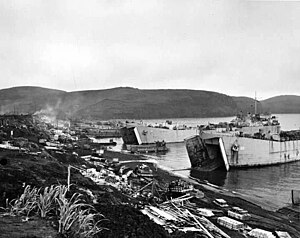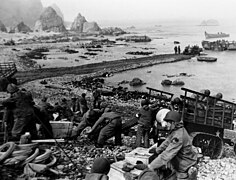| Operation Cottage | |||||||
|---|---|---|---|---|---|---|---|
| Part of the Aleutian Islands campaign of World War II | |||||||
 American troops landing on Kiska | |||||||
| |||||||
| Belligerents | |||||||
|
|
| ||||||
| Commanders and leaders | |||||||
|
| Not present | ||||||
| Units involved | |||||||
| None present | ||||||
| Strength | |||||||
|
| Sea mines, mines, booby traps | ||||||
| Casualties and losses | |||||||
|
92 killed 221 wounded Landing forces: 32 killed 100 wounded U.S Navy: 1 destroyer (USS Abner Read) heavily damaged 71 killed 47 wounded | None | ||||||
Operation Cottage was a tactical maneuver which completed the Aleutian Islands campaign. On August 15, 1943, Allied military forces landed on Kiska Island, which had been occupied by Japanese forces since June 1942. However, the Japanese had secretly abandoned the island two weeks earlier, and so the Allied landings were unopposed. Allied forces suffered over 500 casualties in total during the operation from Japanese landmines and booby traps, friendly fire incidents, and vehicle accidents.
Background
| Aleutian Islands campaign | |
|---|---|
The Japanese under Captain Takeji Ono had landed on Kiska on June 6, 1942 with 500 troops of Special Naval Landing Forces. Soon after arrival, they stormed a United States weather station, where they killed two and captured eight United States Navy officers. The captured officers were sent to Japan as prisoners of war. Another 2,000 Japanese troops arrived, landing in Kiska Harbor. At this time, Rear Admiral Monzo Akiyama headed the force on Kiska. In December 1942, additional anti-aircraft units, engineers, and a negligible number of reinforcement infantry arrived on the island. In the spring of 1943, control was transferred to Lt. General Kiichiro Higuchi.
Invasion plan and execution

After the heavy casualties suffered at Attu Island, Japanese planners were expecting another costly operation. They realized the isolated Kiska Island was no longer defensible and planned for an evacuation. Starting in late July, there were increasing signs of Japanese withdrawal. Aerial photograph analysts noticed that routine activities appeared to greatly diminish, and almost no movement could be detected in the harbor. Bomb damage appeared unrepaired, and aircrews reported greatly diminished anti-aircraft fire. On July 28, 1943, radio signals from Kiska ceased entirely.
On August 15, 1943, the U.S. 7th Infantry Division, 87th Mountain Infantry Regiment of the 10th Mountain Division and the 13th Canadian Infantry Brigade from the 6th Canadian Infantry Division, landed on opposite shores of Kiska. Canadian regiments landed included the Canadian Fusiliers; the Winnipeg Grenadiers; the Rocky Mountain Rangers; and the Saint John Fusiliers. The invasion also involved the first combat deployment of the First Special Service Force, an elite special forces unit consisting of American and Canadian commandos.
Both U.S. and Canadian forces mistook each other, after a Canadian soldier shot at U.S. lines believing they were Japanese, and a friendly fire incident occurred, which left 28 Americans and 4 Canadians dead, with 50 wounded on either side. Progress was also hampered by mines, timed bombs, accidental ammunition detonations, vehicle accidents and booby traps that caused further casualties. A stray Japanese sea mine caused the USS Abner Read (DD-526) to lose a large chunk of its stern. The blast killed 71 and wounded 47 personnel.
Gallery
See also
Notes
- ^ Kostka, Del C. (December 30, 2014). "Operation Cottage: A Cautionary Tale of Assumption and Perceptual Bias". Joint Force Quarterly. National Defense University Press. Retrieved December 20, 2021.
- ^ "The Battle for Kiska", Canadian Heroes, canadianheroes.org, 13 May 2002,
Originally Published in Esprit de Corp Magazine, Volume 9 Issue 4 and Volume 9 Issue 5
- ^ "Operation COTTAGE". www.canadiansoldiers.com. Retrieved 2022-05-25.
References
- Feinberg, Leonard (1992). Where the Williwaw Blows: The Aleutian Islands-World War II. Pilgrims' Process, Inc. ISBN 0-9710609-8-3.
- Garfield, Brian The Thousand Mile War, Aurum Press, 1995 ISBN 1-84513-019-7
- Goldstein, Donald M.; Katherine V. Dillon (1992). The Williwaw War: The Arkansas National Guard in the Aleutians in World War. Fayetteville, Arkansas, USA: University of Arkansas Press. ISBN 1-55728-242-0.
- Morison, Samuel Eliot (2001) . Aleutians, Gilberts and Marshalls, June 1942-April 1944, vol. 7 of History of United States Naval Operations in World War II. Champaign, Illinois, US: University of Illinois Press. ISBN 0-316-58305-7.
- Perras, Galen Roger (2003). Stepping Stones to Nowhere, The Aleutian Islands, Alaska, and American Military Strategy, 1867 - 1945. Vancouver British Columbia: University of British Columbia Press. ISBN 1-59114-836-7.
External links
- Logistics Problems on Attu by Robert E. Burks.
- Operation Cottage at canadiansoldiers.com
- Aleutian Islands Chronology
- Aleutian Islands War
- Red White Black & Blue - feature documentary about The Battle of Attu in the Aleutians during World War II
- Soldiers of the 184th Infantry, 7th ID in the Pacific, 1943-1945
- World War II Aleutian Islands: The U.S. Army Campaigns of World War II Archived 2014-03-17 at the Wayback Machine from the United States Army Center of Military History.
- "Kiska". Retrieved 2018-03-11.
- A film clip ALLIES TAKE KISKA ETC. (1943) is available for viewing at the Internet Archive
| History of Alaska | |||
|---|---|---|---|
 | Timeline of Alaska |  | |
| Topics and events |
| ||
- Aleutian Islands campaign
- American Theater of World War II
- Pacific Ocean theater of World War II
- Battles involving the United States
- Battles of World War II involving the United States
- Battles of World War II involving Canada
- Friendly fire incidents of World War II
- Amphibious operations of World War II
- August 1943 events
- Amphibious operations involving the United States
- Amphibious operations involving Canada







